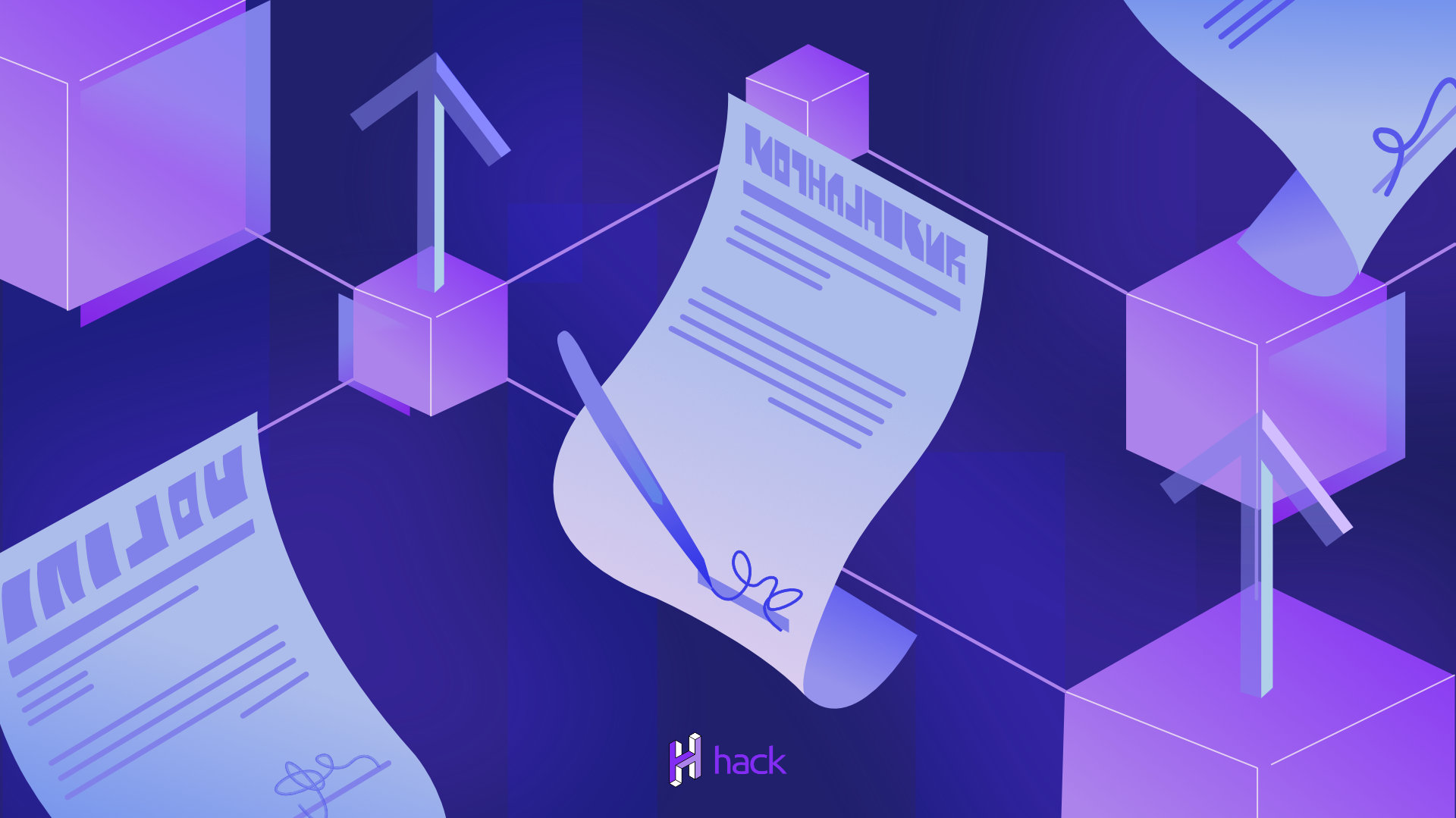The world would not have been the same today without the internet. It touches just about every aspect of how we live, work, socialise, shop, and entertain. But access to the internet is a recent phenomenon that has reshaped the world in a stunningly short amount of time. In just a few decades, the internet has gone from a novel way for the US military to keep in touch to the always-connected heartbeat of the human race that we know it.
Initially, the internet was created to make sharing information easier, but over time it has become a natural extension of how we communicate and interact with life. Today, as our personal information is continuously harvested but our working and social lives are mostly online, understanding this global network is more important than ever.
And as the only constant in life is change, every day new technologies are being developed to promise the development of alternatives to the internet’s centralised hubs.
But how did everything start, what are the three main nets and how did we get here…
The History of the Internet in a Nutshell
1969: Arpanet
Arpanet was the first real network to run on packet switching technology.
On October 29, 1969, computers at Stanford and UCLA connected for the first time. In effect, they were the first hosts on what would one day become the Internet. The first message sent across the network was supposed to be “Login”, but reportedly, the link between the two colleges crashed on the letter “g”.
1971: Email
The email was first developed in 1971 by Ray Tomlinson, who also made the decision to use the “@” symbol to separate the user name from the computer name (which later on became the domain name).
1971: Project Gutenberg and eBooks
One of the most impressive developments of 1971 was the start of Project Gutenberg. Project Gutenberg, for those unfamiliar with the site, is a global effort to make books and documents in the public domain available electronically–for free–in a variety of eBook and electronic formats.
It began when Michael Hart gained access to a large block of computing time and came to the realization that the future of computers wasn’t in computing itself, but in the storage, retrieval and searching of information that, at the time, was only contained in libraries.
1972: CYCLADES
France began its own Arpanet-like project in 1972, called CYCLADES. While the Cyclades was eventually shut down, it did pioneer a key idea: the host computer should be responsible for data transmission rather than the network itself.
1973: The first trans-Atlantic connection and the popularity of emailing
Arpanet made its first trans-Atlantic connection in 1973, with the University College of London. During the same year, email accounted for 75% of all Arpanet network activity.
1974: The beginning of TCP/IP
A proposal was published to link Arpa-like networks together into a so-called “inter-network”, which would have no central control and would work around a transmission control protocol (which eventually became TCP/IP).
1977: The PC modem
1977 was a big year for the development of the Internet as we know it today. It’s the year the first PC modem, developed by Dennis Hayes and Dale Heatherington, was introduced and initially sold to computer hobbyists.
1978: Spam is born
1978 is also the year that brought the first unsolicited commercial email message (later known as spam), sent out to 600 California Arpanet users by Gary Thuerk.
1982: The first emoticon
While many people credit Kevin MacKenzie with the invention of the emoticon in 1979, it was Scott Fahlman in 1982 who proposed using ???? after a joke, rather than the original -) proposed by MacKenzie. The modern emoticon was born.
1983: Arpanet computers switch over to TCP/IP
January 1, 1983, was the deadline for Arpanet computers to switch over to the TCP/IP protocols developed by Vinton Cerf. A few hundred computers were affected by the switch. The name server was also developed in ’83.
1984: Domain Name System (DNS)
The domain name system was created in 1984 along with the first Domain Name Servers (DNS).
1985: Virtual communities
1985 brought the development of The WELL (short for Whole Earth ‘Lectronic Link), one of the oldest virtual communities still in operation. It started out as a community of the readers and writers of the Whole Earth Review and was an open but “remarkably literate and uninhibited intellectual gathering”.
Wired Magazine once called The Well “The most influential online community in the world.”
1988: IRC – Internet Relay Chat
Also in 1988, Internet Relay Chat (IRC) was first deployed, paving the way for real-time chat and the instant messaging programs we use today.
1988: First major malicious internet-based attack
One of the first major Internet worms was released in 1988. Referred to as “The Morris Worm”, it was written by Robert Tappan Morris and caused major interruptions across large parts of the Internet.
1989: The proposal for the World Wide Web
1989 also brought about the proposal for the World Wide Web, written by Tim Berners-Lee. It was written to persuade CERN that a global hypertext system was in CERN’s best interest. It was originally called “Mesh”; the term “World Wide Web” was coined while Berners-Lee was writing the code in 1990.
1991: First web page created
1991 brought some major innovations to the world of the Internet. The first web page was created and, much like the first email explained what email was, its purpose was to explain what the World Wide Web was.
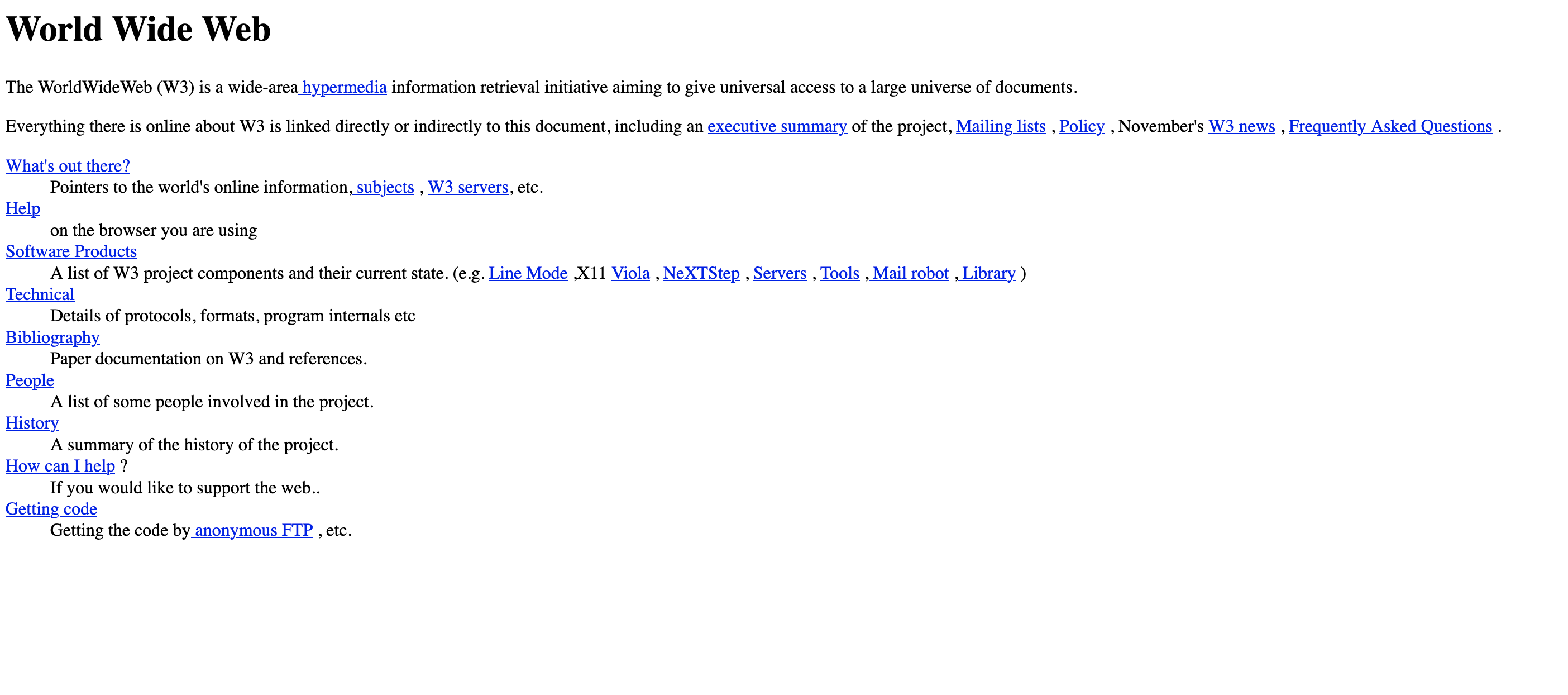
1991: First content-based search protocol
Also in the same year, the first search protocol that examined file contents instead of just file names was launched, called Gopher.
1991: MP3 becomes a standard
Also, the MP3 file format was accepted as a standard in 1991. MP3 files, being highly compressed, later become a popular file format to share songs and entire albums via the internet.
1991: The first webcam
One of the more interesting developments of this era, though, was the first webcam. It was deployed at a Cambridge University computer lab, and its sole purpose was to monitor a particular coffee maker so that lab users could avoid wasted trips to an empty coffee pot.
1993: Mosaic – first graphical web browser for the general public
The first widely downloaded Internet browser, Mosaic, was released in 1993. While Mosaic wasn’t the first web browser, it is considered the first browser to make the Internet easily accessible to non-techies.
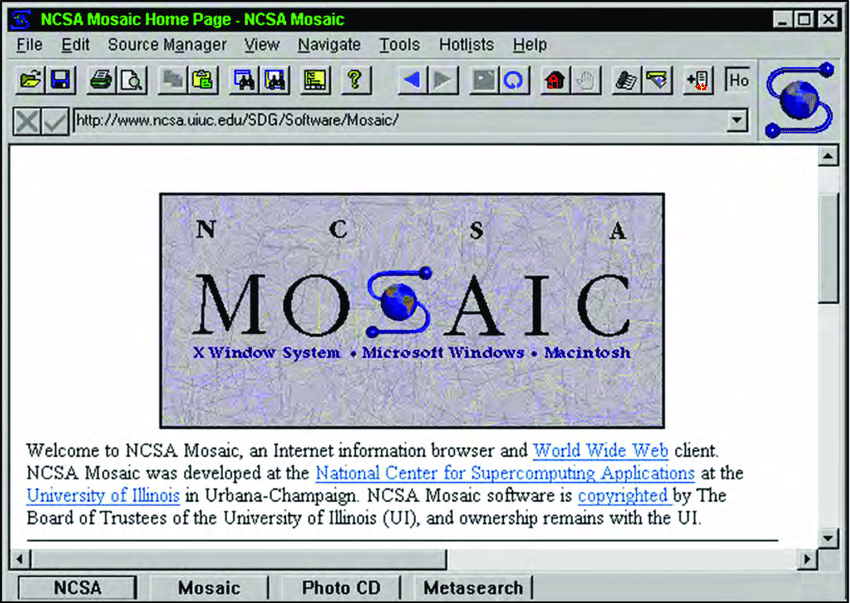
1996: First web-based (webmail) service
In 1996, HoTMaiL (the capitalized letters are a homage to HTML), the first webmail service, was launched.
1997: The term “weblog” is coined
While the first blogs had been around for a few years in one form or another, 1997 was the first year the term “weblog” was used.
1998: First new story to be broken online instead of traditional media
In 1998, the first major news story to be broken online was the Bill Clinton/Monica Lewinsky scandal (also referred to as “Monicagate” among other nicknames), which was posted on The Drudge Report after Newsweek killed the story.
1998: Google!
Google went live in 1998, revolutionizing the way in which people find information online.
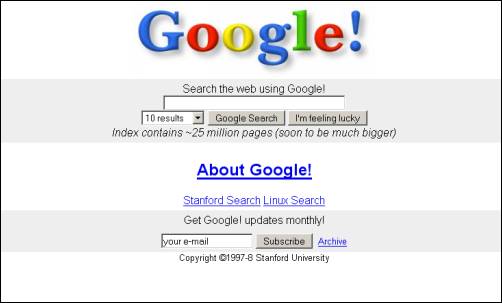
1998: Internet-based file-sharing gets its roots
In 1998 as well, Napster launched, opening up the gates to mainstream file-sharing of audio files over the internet.
1999: SETI@home project
1999 is the year when one of the more interesting projects ever brought online: the SETI@home project was launched. The project has created the equivalent of a giant supercomputer by harnessing the computing power of more than 3 million computers worldwide, using their processors whenever the screensaver comes on, indicating that the computer is idle.
The program analyzes radio telescope data to look for signs of extraterrestrial intelligence.
2001: Wikipedia is launched
With the dotcom collapse still going strong, Wikipedia launched in 2001, one of the websites that paved the way for collective web content generation/social media.
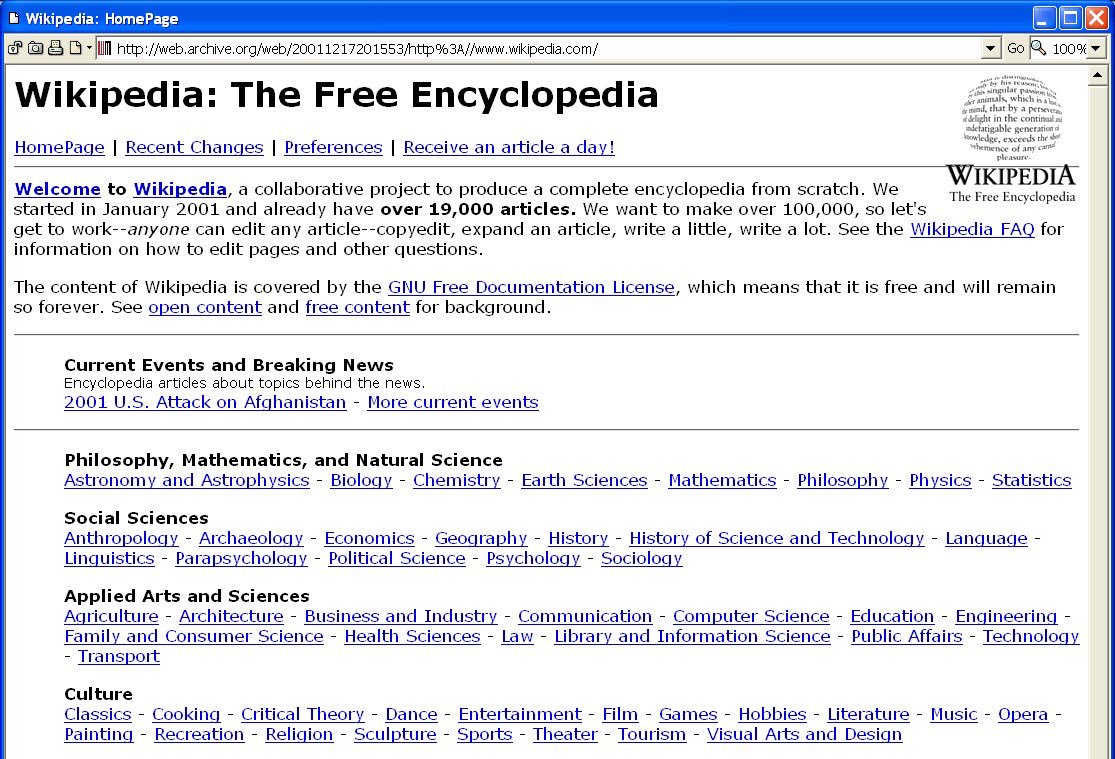
2003: MySpace becomes the most popular social network
Also in 2003, MySpace opens up its doors. It later grew to be the most popular social network at one time (though it has since been overtaken by Facebook).
2004: Web 2.0
Though coined in 1999 by Darcy DiNucci, the term “Web 2.0”, referring to websites and Rich Internet Applications (RIA) that are highly interactive and user-driven became popular around 2004.
During the first Web 2.0 conference, John Batelle and Tim O’Reilly described the concept of “the Web as a Platform“: software applications built to take advantage of internet connectivity, moving away from the desktop (which has downsides such as operating system dependency and lack of interoperability).
2004: “The” Facebook open to college students
Facebook launched in 2004, though at the time it was only open to college students and was called “The Facebook”; later on, “The” was dropped from the name.
2005: YouTube – streaming video for the masses
YouTube launched in 2005, bringing free online video hosting and sharing to the masses.
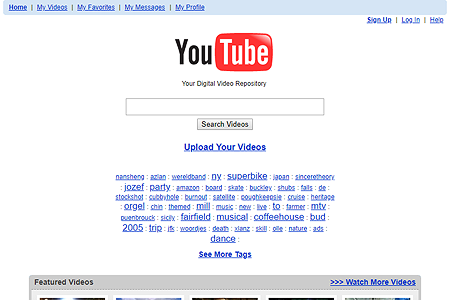
2006: Twitter
Twitter launched in 2006. It was originally going to be called twittr (inspired by Flickr); the first Twitter message was “just setting up my twttr”.
2007: The iPhone and the Mobile Web
The biggest innovation of 2007 was almost certainly the iPhone, which was almost wholly responsible for renewed interest in mobile web applications and design.
2009: ICANN policy changes
2009 brought about one of the biggest changes to come to the Internet in a long time when the U.S. relaxed its control over ICANN, the official naming body of the Internet (they’re the organization in charge of registering domain names).
2009: Satoshi Nakamoto launches the Bitcoin network
A digital cash system on a decentralized, cryptographically-secure peer-to-peer protocol — the first blockchain. The technology enables a vision of decentralized networks with distributed consensus that securely execute verifiable transactions without the need for central authorities. You can check our extensive Bitcoin Guide and find out more.
2013: Edward Snowden
A former CIA employee and National Security Agency (NSA) contractor, reveals that the NSA had in place a monitoring program capable of tapping the communications of thousands of people, including U.S. citizens.
2015: The Ethereum Virtual Machine
An open-source, blockchain computing platform was launched. It quickly becomes a popular way for developers to deploy decentralized apps that range from games and social media to decentralized finance (DeFi).
2016: Google unveils Google Assistant
a voice-activated personal assistant program, marking the entry of the internet giant into the “smart” computerized assistant marketplace. Google joins Amazon’s Alexa, Siri from Apple, and Cortana from Microsoft.
2018: There is a significant rise in internet-enabled devices
An increase in the Internet of Things (IoT) sees around seven billion devices by the end of the year.
2019: Fifth–generation (5G) networks
5G networks are launched, enabling speedier internet connection on some wireless devices.
2021: By January 2021, there are 4.66 billion people connected to the internet
This is more than half of the global population.
2022: Low–Earth orbit satellite internet is closer to reality
By early January 2022, SpaceX launches more than 1,900 Starlink satellites overall. The constellation is now providing broadband service in select areas around the world.
Now as we have a timeline of the evolution of the net, let’s break down the 3 stages of the Web and their main features and differences:
Web 1.0
Web 1.0 refers to the first stage of the World Wide Web evolution. Earlier, there were only a few content creators with a huge majority of users/consumers of content. Personal web pages were common, consisting mainly of static pages hosted on ISP-run web servers, or on free web hosting services.
In Web 1.0 advertisements on websites while surfing the internet are banned. Web 1.0 is a content delivery network (CDN) that enables the showcase of the piece of information on the websites. It can be used as a personal website or business card. This web version is also known as “the read-only Web” because it lacks the necessary forms, visuals, controls, and interactivity we enjoy on today’s Internet. The era of Web 1.0 was roughly from 1991 to 2004.
Design essentials of a Web 1.0 site include:
- Static pages.
- Content is served from the server’s file system.
- Pages built using Server Side Includes or Common Gateway Interface (CGI).
- Frames and Tables are used to position and align the elements on a page.
Web 2.0
Web 2.0 refers to worldwide websites which highlight user-generated content, usability, and interoperability for end users. This Internet form emphasizes User-Generated Content (UGC), ease of use, interactivity, and improved compatibility with other systems. Web 2.0 is all about the end user’s experience. Consequently, this Web form was responsible for creating communities, collaborations, and social media. As a result, Web 2.0 is considered the primary form of web interaction for most of today’s users.
If Web 1.0 was called “the read-only Web,” Web 2.0 is “the participative social Web.” Web 2.0 is a better, more enhanced version of its predecessor, incorporating web browser technologies such as JavaScript frameworks.
Features of Web 2.0:
- Free sorting of information, permits users to retrieve the information collectively.
- Dynamic content.
- Information flows between the site owner and site users by means of evaluation & online commenting.
- Developed APIs to allow self-usage, such as by a software application.
- Web access leads to concerns different, from the traditional Internet user base to a wider variety of users.
- The end-user is not only a user of the application but also a participant with tools like – podcasting, blogging, tagging, curating with RSS, social bookmarking, social networking
You’re using Web 2.0 at this exact moment, you know. 🙂
Web 3.0
Web 3.0 (Web3) is built on a foundation consisting of the core ideas of decentralization, openness, and more excellent user utility. While Web 1.0 is the “read-only Web,” and Web 2.0 is the “participative social Web,” – Web 3.0 is the “read, write, execute Web.”
This Web interaction and utilization stage moves users away from centralized platforms like Facebook, Google, or Twitter and towards decentralized, nearly anonymous platforms. It refers to the evolution of web utilization and interaction which includes altering the Web into a database, with the integration of DLT (Distributed Ledger Technology blockchain is an example) and that data can help to make Smart Contracts based on the needs of individuals.
Main features and technologies that define and align with Web 3.0:
- Semantic Web – The semantic web improves web technologies in demand to create, share and connect content through search and analysis based on the capability to comprehend the meaning of words, rather than on keywords or numbers.
- Artificial Intelligence – Combining this capability with natural language processing, in Web 3.0, computers can distinguish information like humans in order to provide faster and more relevant results. They become more intelligent to fulfil the requirements of users.
- 3D Graphics – The three-dimensional design is being used widely in websites and services in Web 3.0. Museum guides, computer games, e-commerce, geospatial contexts, etc. are all examples that use 3D graphics.
- Connectivity – With Web 3.0, information is more connected thanks to semantic metadata. As a result, the user experience evolves to another level of connectivity that leverages all the available information.
- Ubiquity – Content is accessible by multiple applications, every device is connected to the web, and the services can be used from any point of the world.
- DLT and Smart contracts – With the help of DLT we can have a virtually impossible way to hack databases. This is the technology which enables a trustless society by the integration of smart contracts which do not need to have a middle man to be a guarantor to make that contract occur on a certain cause. It’s a powerful tool which can make the world a far better place and generate more opportunities for everyone on the internet.
Web 3.0 ultimately lets users interact, exchange information, and securely conduct financial transactions without a centralized authority or coordinator. As a result, each user becomes a content owner instead of just a content user.
Remember that Web 3.0 isn’t entirely in place. However, we are already seeing elements of Web 3.0 working their way into our Internet experiences, such as NFTs, Blockchain and Distributed Ledgers. Additionally, Siri is Web 3.0 technology, as is the Internet of Things. However, if and when the full implementation happens, it will be closer to Berners-Lee’s initial vision of Web 3.0. As he puts it, it will be a place with “no permission is needed from a central authority to post anything … there is no central controlling node, and so no single point of failure … and no “kill switch.”




